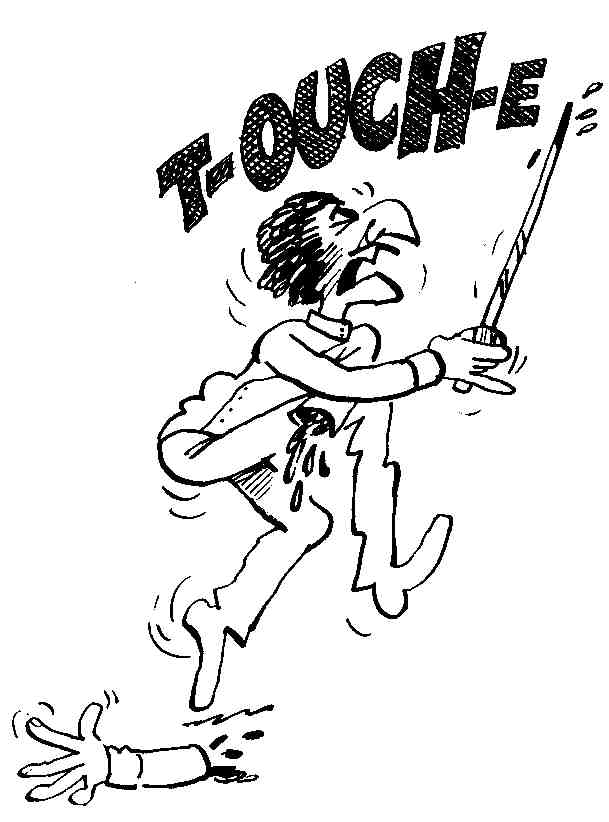
LANGUAGE - THE TWO-EDGED SWORD
Part
I of a Nurturing Potential series
“Language is apparently a sword which cuts both ways. With its help man can conquer the unknown; with it he can grievously wound himself."(1)

[Illustration by Albert Saunders from An ABC of NLP]
Language is the name we give to the vehicle we use for communicating ideas. We encode perceptual phenomena into awareness which is manipulated by the mind in order to make sense out of experience. Features of this awareness are objectified and associated with sounds. When these sounds are uttered and become the recognised sounds for the objectified phenomena they are referred to as words.
There are, however, two major problems. One is a tendency to identify the words with the object they represent. The other is the failure correctly to identify abstractions. In the first case it is useful to employ a word coined the best part of a century ago to distinguish labels for objects (i.e. words) from the objects themselves. For example, we may call a certain animal a "dog". This is the label we give to a four-legged creature, usually with a tail, that enables that creature to be identified. The word, though, is not the animal. If, however, we term the dog itself a "referent", this distinguishes the animal as a physical entity, as distinct from the label used to describe it.
Language is, capable of both enhancing and limiting our perception of the world; for example, "Eskimos have some seventy different words for snow"(2); and much language, particularly of the more primitive kind, is not primarily concerned with ideas at all.
But while it is a simple matter to identify the referent when the label "dog" is used, even though we may not all imagine the same breed of dog, it is somewhat more complicated to apply a similar simplification to an abstract idea.
"No matter what names you humans give to things [said Josie the chimpanzee], we chimpanzees go right on enjoying life. It isn't so with humans . . . The names you uncaged primates give things affect your attitude towards them forever after. You lose your insight because you are always holding up a screen of language between you and the real world."(3)
Stuart Chase (1) has divided labels into three classes, in ascending order of difficulty:
1. Labels for common objects such as dogs (or chairs, or books).
2. Labels for collections of things such as "mankind", "consumer goods", Germany, "the white race", "the courts".
3. Labels for abstract ideas and qualities, such as "freedom", "individualism", "truth", "the sublime".
Noam Chomsky, in his first book(4), outlined his system of transformational grammar. This grammar consists of surface structures - the sounds and words in a sentence - and deep structures that contain the meaning of the sentence. The meaning is converted by a transformation - any of an ordered set of rules - to a surface structure. In other words, everyday language is the surface structure of a communication, whereas it is the deep structure that is filtered via biological constraints and social rules into the simplest form capable of containing meaning.
Chomsky says that children are born with a knowledge of the principles of the grammatical structure of all languages, and this inborn knowledge explains the success and speed with which they learn language. Anyone who has observed a child develop from 18 months to 8 years will appreciate this view.
For language adequately to communicate concepts, it must be able to transmit the deep structure of a message. Since the word is not the experience, a language must be able (a) to interpret an idea properly; (b) to form a legitimate internal representation of that idea; and (c) to convey an adequately accurate internal representation of that idea to the other person.
The problem in communicating by language arises from the fact that we each have our own, unique representation of reality, i.e. we do not all share the same model of reality. It is easy for us to accept a failure to communicate when speaking to (or listening to) someone in another language with which we/they are unfamiliar. It is less easy to appreciate, when we are both using the same language, that we may be suffering a similar failure to communicate, because we are interpreting words in a different way, or because we are using different representational systems.
"There's an illusion that people understand each other when they repeat the same words. But since those words internally access different experience - which they must - then there's always going to be a difference in meaning.
"There's a slippage between the word and the experience, and there's also a slippage between my corresponding experience for a word and your corresponding experience for the same word. I think it's extremely useful for you to behave so that your clients . . . have the illusion that you understand what they are saying verbally. I caution you against accepting the illusion for yourself."(2)
![]()
(1) The Tyranny of Words. Stuart Chase.
(2) Frogs Into Princes. Bandler and Grinder.
(3) Adam's Rib. Ruth Herschberger. (Pellegrini & Cudahy, 1948) [Josie, a female chimpanzee is the subject of a study arguing that males are naturally dominant over females and that females naturally engage in prostitution. In the interview, Josie tells her side of the story. She points out flaws in the experiment and offers a more woman-centered interpretation of her actions. Herschberger has written a very funny, satirical piece, which calls into question assumptions about gender issues.] Some of Herschberger's poetry may be seen on our Verse page.
(4) Syntactic Structures. Noam Chomsky. (1957)
Recommended reading:
Language in Thought and Action - S.I. Hayakawa
Language and Mind. Noam Chomsky
The Meaning of Meaning. C.K. Ogden and L.A. Richards.
Usage and Abusage. Eric Partridge.
Science and Sanity. Alfred Korzybski.